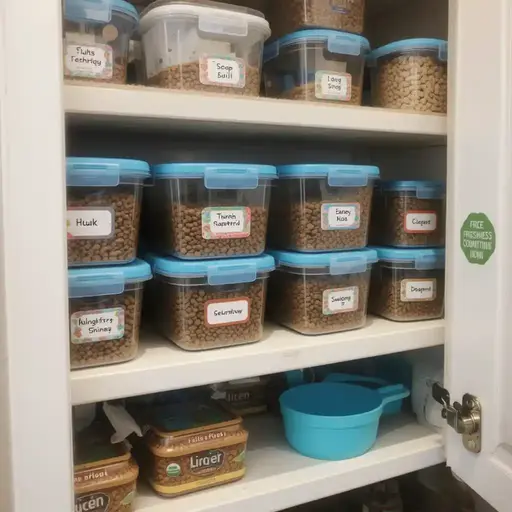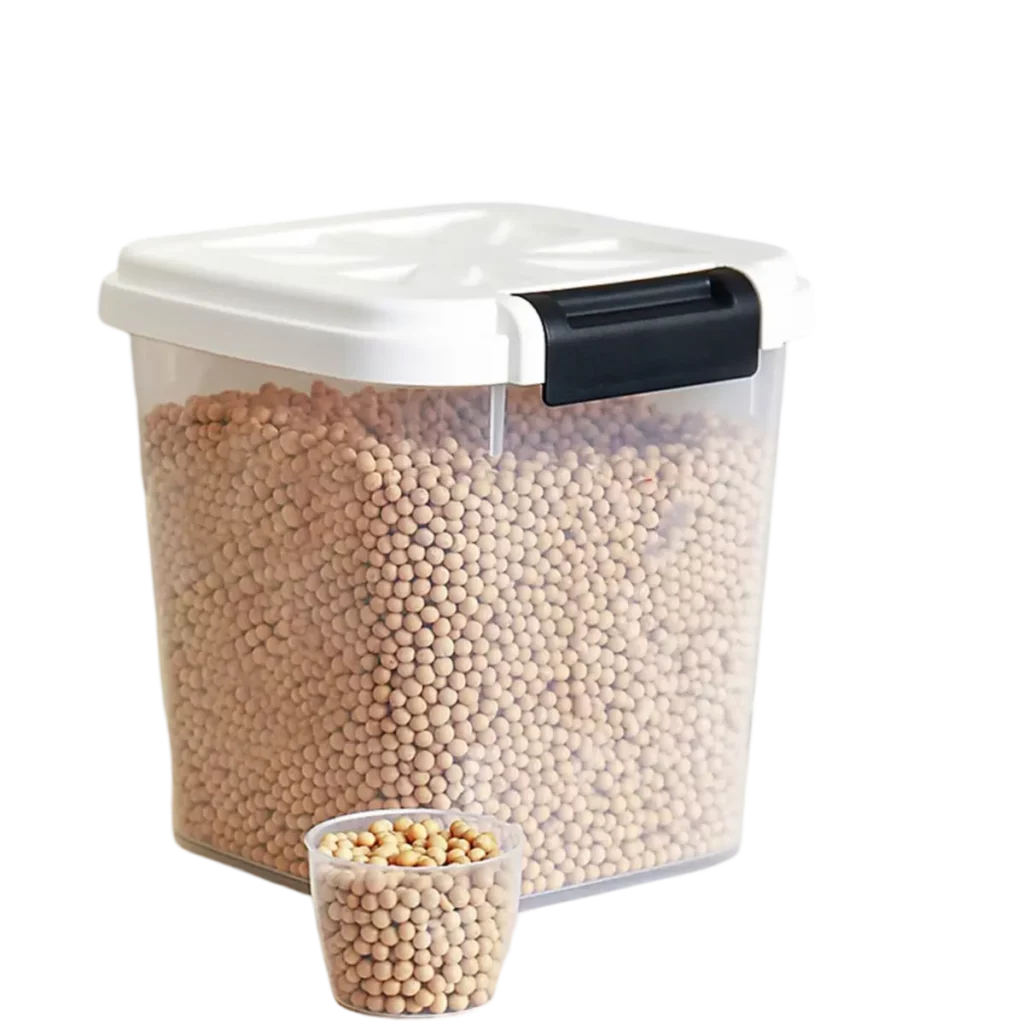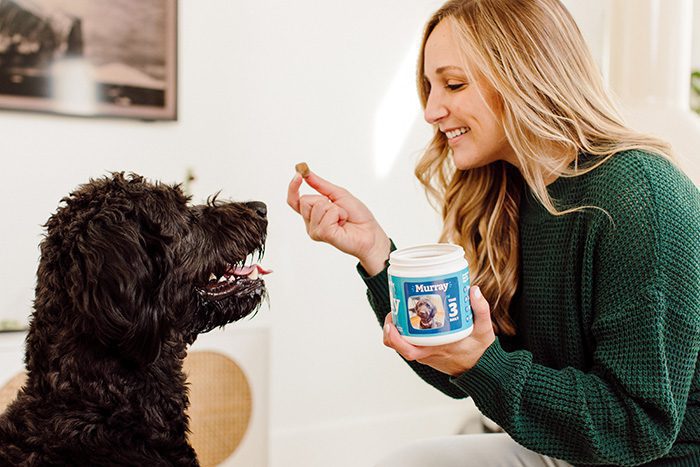Proper storage of dog food is not merely a matter of convenience—it’s a critical factor in safeguarding your pet’s health.
Improperly stored food can lose nutritional value, attract pests, or become contaminated with moisture and bacteria, potentially leading to digestive issues or long-term health risks.
For instance, exposure to humidity can degrade essential nutrients like vitamins and antioxidants, while open packaging invites infestations from insects or rodents.
These risks underscore the importance of adopting storage solutions designed to mitigate such vulnerabilities.
Dog food containers have emerged as a vital tool for pet owners prioritizing freshness, safety, and longevity in their pet’s diet.
By creating a barrier against environmental threats, such as oxygen, mold, and temperature fluctuations, these containers help maintain the integrity of kibble and wet food alike.
Beyond preservation, they offer practical advantages like odor control, portion management, and streamlined feeding routines.
However, selecting the right container requires careful consideration of material durability, airtight seals, and hygiene compatibility to maximize benefits.
Benefits of Using Dog Food Storage Containers

Maintaining Freshness Through Scientific Preservation
Airtight dog food storage solutions act as a critical defense against environmental degradation.
Exposure to oxygen accelerates lipid oxidation, degrading essential fatty acids and fat-soluble vitamins (e.g., vitamin E), while moisture fosters mold growth and bacterial proliferation.
Containers with hermetic seals—such as those featuring snap-lock latches or silicone gaskets—minimize these risks, extending shelf life by up to 50% compared to open bags.
Studies show that dry kibble stored in such systems retains its crunch and nutrient profile significantly longer, preserving palatability and bioavailability.
Protecting Against Pests and Contamination
Rodents and insects are attracted to the volatile organic compounds released by pet food, posing hygiene risks and potential disease transmission.
High-quality containers with reinforced lids and pest-resistant materials (e.g., thick plastic or stainless steel) create an impermeable barrier, preventing infestations.
For example, metal containers deter gnawing, while food-grade plastic options resist microbial growth.
This dual protection ensures compliance with FDA guidelines for safe pet food handling.
Odor Control for a Healthier Home Environment
Unpleasant smells from stored dog food often stem from volatile sulfur compounds and rancid fats.
Airtight systems neutralize these odors by trapping them within the container, improving indoor air quality and reducing cross-contamination risks in kitchens.
Pet owners with multiple animals or sensitive noses report a 70% reduction in lingering smells when using odor-lock designs.
Streamlining Feeding Routines with Portion Management
Containers with built-in measuring cups or adjustable dividers simplify precise portioning, aligning with veterinary recommendations for weight management and dietary consistency.
This feature reduces overfeeding—a leading cause of canine obesity—and minimizes waste, saving an average of 10–15% on annual food costs.
Aesthetic Integration with Modern Kitchens
Gone are the days of bulky, utilitarian bins. Contemporary dog food storage containers blend functionality with design, offering sleek shapes, matte finishes, and muted tones that complement minimalist or rustic decor.
Brands now prioritize ergonomic handles and stackable designs, optimizing space without compromising style.
Ensuring Safety for All Household Members
Childproof latches and elevated storage positions prevent accidental spills or contamination from curious toddlers or other pets.
Food-grade materials (e.g., BPA-free plastics) further eliminate leaching risks, ensuring compliance with EU and FDA safety standards.
This proactive approach reduces vet visits linked to ingestion of spoiled food or foreign contaminants.
Eco-Conscious Choices for Sustainable Pet Ownership
The rise of biodegradable plastics and recyclable steel containers addresses growing concerns about pet product sustainability.
For instance, containers made from post-consumer recycled materials reduce landfill waste by 30%, while durable stainless steel options last decades, cutting long-term plastic dependency.
Pairing these choices with bulk purchasing further lowers the carbon footprint of pet care.

Key Considerations When Choosing a Dog Food Container
Size and Capacity: Aligning with Storage Needs
Selecting the right size ensures efficient storage and minimizes exposure to air and moisture. For example:
- Small households: A 5–10 lb container suits single-dog owners buying smaller bags.
- Multi-dog households: Opt for 20–50 lb containers to accommodate bulk purchases while maintaining freshness.
Always leave 10–15% extra space to avoid overfilling, which can compromise airtight seals.
Material Options: Balancing Pros and Cons
Different materials cater to varying priorities, from durability to hygiene:
- Plastic: Lightweight and budget-friendly, but prone to odor absorption over time. Look for BPA-free variants to prevent chemical leaching.
- Stainless Steel: Pest-resistant, non-porous, and ideal for long-term storage, though heavier and costlier
- Glass: Non-toxic and easy to sanitize, but fragile and less practical for large quantities.
- Ceramic: Stylish and odor-resistant but susceptible to chipping, making it better suited for decorative, low-risk environments.
Airtight Seals: The Science of Freshness
An effective airtight seal is non-negotiable for preserving nutritional integrity.
Containers with silicone gaskets or vacuum-sealed lids block oxygen and moisture, slowing oxidation and mold growth.
Studies show that even minor gaps in seals can reduce shelf life by 30% due to lipid degradation.
Prioritize designs tested for 360° sealing, such as those with interlocking lids or clamps.
Usability Features: Enhancing Daily Convenience
Practical design elements streamline feeding routines:
- Easy-open lids: Hinged mechanisms or push-button locks simplify access, especially for seniors or those with mobility challenges.
- Handles and wheels: Large containers benefit from ergonomic grips or casters for mobility
- Built-in scoops/dividers: Integrated measuring cups or portion separators reduce waste and align with vet-recommended feeding guidelines.
- Stackable designs: Vertical stacking optimizes limited storage space without sacrificing accessibility.
Durability: Withstanding Wear and Tear
Frequent use demands robust materials resistant to cracking, warping, or scratches that harbor bacteria.
Stainless steel and thick-walled plastics excel in high-traffic areas, while thinner plastics degrade faster under UV exposure or temperature fluctuations.
For outdoor storage, UV-resistant coatings prevent brittleness.
Cost-Effectiveness: Investing in Long-Term Value
While budget-friendly options exist, prioritize longevity over upfront cost.
A $50 stainless steel container outlasts three $15 plastic ones over five years, cutting waste and replacement hassles.
Eco-conscious buyers might opt for recyclable materials to offset environmental impact.
Brand Reliability: Trusting Proven Expertise
Reputable brands adhere to FDA or EU food safety standards, ensuring materials are non-toxic and microbial-resistant
Research third-party certifications (e.g., NSF International) and read reviews for real-world performance insights.
Customization and Smart Technology
Modern innovations cater to niche needs:
- Personalized labels: Engraved names or portion markings reduce confusion in multi-pet homes.
- Smart dispensers: Wi-Fi-enabled containers track inventory, automate refills, or dispense precise portions via app controls—a boon for busy owners.

Types of Dog Food Containers
Bins and Canisters: Versatile Solutions for Everyday Use
Standard bins and canisters cater to diverse household needs, offering capacities ranging from 5–50 lbs to match bag sizes. Key features include:
- Material variety: Choose from plastic (lightweight, BPA-free options), stainless steel (pest-resistant, durable), or glass (odor-neutral, non-reactive).
- Airtight designs: Lids with silicone gaskets or interlocking seals preserve freshness by blocking moisture and oxygen, extending shelf life by up to 50%.
- Hygiene focus: Non-porous surfaces resist bacterial growth, aligning with FDA food safety standards
Stackable Containers: Maximizing Space Efficiency
Ideal for compact kitchens or multi-pet households, stackable systems optimize vertical storage while maintaining accessibility:
- Modular designs: Interlocking lids and flat bases enable stable stacking, reducing floor space usage by 40% compared to standalone bins.
- Integrated usability: Non-slip bottoms prevent sliding, and clear labeling panels help organize different food types or portions
- Scalability: Add tiers as needed, ensuring flexibility for changing storage demands.
Wheeled Containers: Mobility for Bulk Storage
Designed for large-capacity needs, wheeled bins simplify handling heavy 20–50 lb bags:
- Ergonomic transport: Reinforced wheels and low-center-of-gravity bases ease movement, minimizing strain during refills
- Pest-proof construction: Thick plastic or steel exteriors deter rodents, while tight seals block insects.
- Durability: UV-resistant materials prevent degradation from light exposure, maintaining structural integrity over the years.
Portable Containers: Freshness on the Go
Compact, travel-friendly options ensure consistent feeding routines during trips:
- Airtight seals: Vacuum-sealed lids or screw-top closures prevent spills and maintain crispness for up to 7 days.
- Lightweight materials: BPA-free plastic or aluminum variants balance portability with impact resistance.
- Portion control: Pre-marked compartments or detachable scoops streamline feeding, adhering to vet-recommended daily intake guidelines.
Specialized Containers: Tailored for Unique Needs
Innovative designs address niche requirements, such as multi-pet households or precise portioning:
- Multi-compartment bins: Dividers separate foods for pets with dietary restrictions or allergies, reducing cross-contamination risks
- Smart dispensers: Wi-Fi-enabled models track inventory, auto-order refills, and dispense pre-set portions via app controls.
- Childproof locks: Tamper-resistant latches keep food secure from toddlers or curious pets, enhancing household safety.
Proper Usage and Maintenance of Dog Food Containers
Cleaning Tips
Proper sanitation prevents bacterial buildup and maintains food quality. Methods vary by material:
- Plastic: Wash with warm, soapy water and a soft sponge to avoid scratches, which can harbor pathogens like Salmonella. Rinse thoroughly to remove detergent residue.
- Stainless Steel: Use food-safe disinfectants or vinegar-water solutions to preserve the non-porous surface and prevent odor retention.
- Glass/Ceramic: Dishwasher-safe options simplify sanitization, but hand-washing with baking soda paste ensures longevity for delicate finishes.
- Frequency: Clean after each bag is emptied or when switching brands to avoid cross-contamination and rancidity
Storing Opened Bags
While some containers are designed to hold food bags upright, transferring food directly into the container maximizes airtight protection. Best practices include:
- Option 1: Discard the original bag and use the container exclusively for optimal freshness, especially for dry kibble prone to lipid oxidation.
- Option 2: Keep the bag inside the container, folding the top tightly or using bag clips to reduce air exposure.
- Sealing hacks: Vacuum-seal systems or oxygen absorbers extend shelf life by 30–50%, critical for high-fat or grain-free formulas susceptible to rancidity
Best Practices for Freshness
Storage conditions directly impact nutritional integrity and safety:
- Location: Place containers in cool, dry areas (e.g., pantries) away from sunlight, which degrades vitamins like A and E through photooxidation
- Temperature: Maintain 50–70°F (10–21°C) to slow microbial growth; avoid fluctuating environments like garages.
- Humidity: Keep relative humidity below 60% to prevent mold and caking in kibble.
- Avoid cross-contamination: Store containers away from household chemicals or raw meat to minimize pathogen transfer.
Storing Homemade or Specialty Diets
Homemade meals and specialty formulas require extra care to retain their benefits:
- Homemade food: Refrigerate for 3–5 days in BPA-free containers or freeze pre-portioned meals in vacuum-sealed bags to preserve nutrients like omega-3 fatty acids.
- Grain-free diets: Prioritize airtight containers to combat faster fat oxidation in legume-based recipes, which are more prone to rancidity
- Rotation protocol: Use the “First In, First Out” (FIFO) method to ensure older batches are consumed first, reducing waste and spoilage risks.
Common Mistakes to Avoid
Storing Food in Original Bags Without Containers
Leaving dog food in its original packaging increases vulnerability to air, moisture, and pests.
Opened bags lack airtight barriers, accelerating nutrient degradation and inviting infestations from insects or rodents.
Transferring food to dedicated storage solutions extends shelf life by blocking oxygen and humidity, which degrade fats and vitamins.
Neglecting Container Hygiene
Infrequent cleaning fosters bacterial growth, including pathogens like Salmonella, which can cause gastrointestinal issues in pets
Residual oils and crumbs in uncleaned bins also attract pests and create odor buildup.
Experts recommend washing containers thoroughly between refills or brand changes to maintain hygiene.
Choosing the Wrong Size
Overly small containers require frequent refills, increasing air exposure and wear on seals.
Conversely, oversized bins waste space and may compromise portion control.
Match container capacity to your dog’s consumption rate—e.g., 5–10 lb bins for single pets, 20–50 lb systems for multi-dog households—to optimize freshness and usability.
Ignoring Airtight Seals
Containers without secure seals fail to block oxygen and moisture, promoting lipid oxidation and mold growth.
Studies show even minor gaps reduce shelf life by up to 30%, particularly for high-fat or grain-free formulas prone to rancidity.
Prioritize designs with silicone gaskets or vacuum-sealed lids for maximum protection.
Overlooking Material Compatibility
Certain materials interact poorly with specific diets. For example, plastic containers may absorb oils from high-fat foods, harboring bacteria and leaching chemicals like BPA over time.
Stainless steel or glass options are safer for fatty or homemade meals, as they resist odor retention and chemical migration.
Conclusion
Proper storage of canine nutrition is a cornerstone of pet health, with airtight solutions playing a pivotal role in preserving freshness, preventing contamination, and safeguarding nutritional integrity.
By creating barriers against moisture, oxygen, and pests, these systems extend shelf life while maintaining essential vitamins and fats critical for a balanced diet..
Additionally, they mitigate odors and streamline feeding routines, enhancing household convenience.
Selecting the ideal storage solution hinges on individual priorities:
- Size: Match capacity to consumption rates to minimize air exposure and optimize space.
- Material: Stainless steel or glass options resist odor retention and chemical leaching, whereas durable plastics offer lightweight affordability
- Features: Prioritize secure seals, easy cleaning, and portion control mechanisms for long-term efficacy.
Investing in a high-quality system transcends convenience—it directly impacts your pet’s well-being.
Contaminated or degraded food increases risks of gastrointestinal distress and nutrient deficiencies, underscoring the value of vet-recommended storage practices.
For deeper insights into dietary management, explore resources on homemade meal preservation, ensuring your dog’s nutritional needs are met with scientific precision.
By aligning practicality with health-focused design, pet owners can transform food storage from a mundane task into a proactive step toward longevity and vitality for their furry companions.




